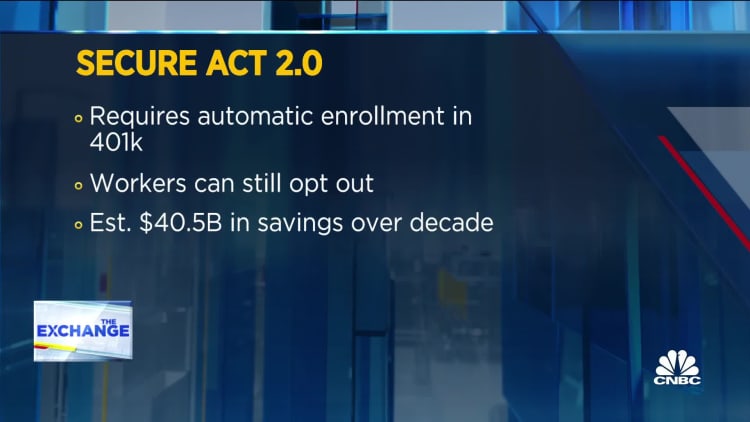A new incentive for low- and moderate-income individuals to save for their post-working years could be on its way.
Under a provision included in a legislative proposal known as “Secure 2.0” — which is included in an omnibus appropriations bill that cleared the Senate on Thursday and awaited a House vote — a retirement “saver’s match” would be implemented, essentially changing how an existing tax credit works.
related investing news

Should the bill pass, people with income under set limits who contribute to a qualified retirement account — i.e., a 401(k) plan — would receive a limited federal “matching” contribution to their nest egg starting in 2027. That amount would be a maximum 50% of up to $2,000 in contributions to a qualifying account (so a maximum $1,000 match per individual).

The match would be phased out (reduced) at income of $41,000 to $71,000 for married couples filing a joint tax return. For single taxpayers, the phase-out range would be $20,500 to $35,500, and for heads of household filers, $30,750 to $53,250.
The current credit isn’t always useful for taxpayers
The move to allow a federal matching contribution is being sought because the current tax credit is nonrefundable, meaning that if you owe no federal income tax, you don’t get the credit.
“The major drawback with the version in law today is that it’s not refundable,” said Shai Akabas, director of economic policy at the Bipartisan Policy Center.
More from Personal Finance:
Pell Grants could rise to a maximum $7,395 next year
1 in 5 young adults have debt in collections, report finds
Here’s how health insurance is helping to cool inflation
“So individuals who have no federal income tax liability, which is most low- and moderate-income earners, get no benefit from that credit,” Akabas said. “This reform is an attempt to make sure those people receive an incentive and a benefit for putting away money for their future.”
The new saver’s match also would be available to some workers who aren’t permitted to use the current tax credit, such as some government employees (i.e., school teachers) and gig workers, said Kristen Carlisle, general manager of Betterment at Work.
The match would be “a direct, substantial way to increase the retirement savings of lower and middle-income workers, and incentivize good retirement planning habits,” Carlisle said.
More than 108 million people would be eligible for the saver’s match, according to the American Retirement Association.
The existing tax break is still available
In the meantime, the existing tax credit remains available and would would stay intact through 2026 if the provision in Secure 2.0 becomes law. However, only 48% of workers are aware of it, according to a 2021 report from the Transamerica Center for Retirement Studies.
The current tax credit can be a maximum of $1,000 (50% of $2,000 in contributions) for single tax filers with up to $20,500 of income in 2022 and heads of households with up to $30,750 in income. For joint filers, the maximum credit is $2,000 (50% of $,4000 in contributions) for those with up to $41,000 of income.
Above those income limits, the credit phases out — is reduced to either 20% or 10% from 50% — up to income of $34,000 (singles), $68,000 (joint filers) and $51,000 (heads of household).
 EU News Digest Latest News & Updates
EU News Digest Latest News & Updates



